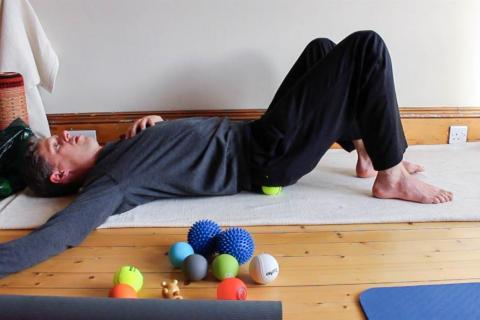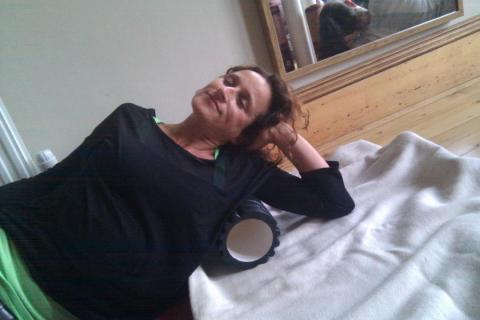Release your weight into balls and rollers and let your tension melt away. Self-massage can unlock the parts of your body you find hard to release with stretching, and help with muscular aches and pains.
Look after your own body
If you learn to massage your own body, then you can get massage any time you need it. You can control the perfect pressure depending on how sensitive each part of your body feels.
I have taught many of my clients and friends just one or two simple techniques that they use regularly to manage a niggling injury or tight area. People do the exercise because in 5 minutes they make a real difference to their health. Each person needs a different technique, depending on their body. My job is to help you to find the technique that your body needs.
Don't worry, it's much easier to learn to massage yourself than to work on someone else because on your own body you can directly feel the sensations from the massage.
Technique
There are various books and classes about "body rolling", and some people perceive it as being a bit brutal! My self-massage method is based on the principles I have learnt to massage others.
- Breath and relax.
- Regulate the pressure to challenge the body without being so intense to cause you to tighten up.
- change the tool for a different size, shape or hardness
- add/remove padding
- change position to increase/decrease the weight on the tool
- Longer holds allow the muscles time to discover how to let go. Experiment to find a good spot, then stay for several breaths or even a couple of minutes. Little movements can work too, perhaps with lighter pressure.
- Whole body relaxation using gravity rather than using muscular force.
- See list of equipment.
Where to massage
With a little common sense, you can safely explore massaging different parts of your body. You can press almost anywhere that is soft connective tissue. Avoid bones, joints, glands, organs and the arteries to the brain.
This means you would benefit from a little basic anatomy knowledge, but even more important is to listen to your body and stop if it doesn't feel good.
Avoid any area with a local condition such as fracture, dislocation, sprain, bruising, cut, inflammation, varicose veins, or painful skin condition.
Safety
- If necessary, consult your GP or health professional to check that massage is safe, or if there are any special requirements. You need to do so if you have a medical condition/health problem, are undergoing medical treatment, feel acute pain, are pregnant, or have any reason to believe massage may be harmful.
- Releasing deep tension can be a bit sore, but it should be in a “feels good” sort of way. Stop immediately if there is sharp pain or it you are not sure. Your mind must be alert to signs that you are harming your body, so avoid massage after alcohol, pain-killers or mind-altering drugs.
- As you move into a technique, apply your weight gradually as you exhale. This gives your body time to adapt and leaves you plenty of time to stop if something is wrong. Avoid sudden or forceful moves.
- Although self-massage is passive, it can be quite demanding for your body and leave you feeling tired. If you have a fever, feel exhausted, or your body is overwhelmed for any other reason, let your body rest.
- If you are not sure, please ask for advice.




